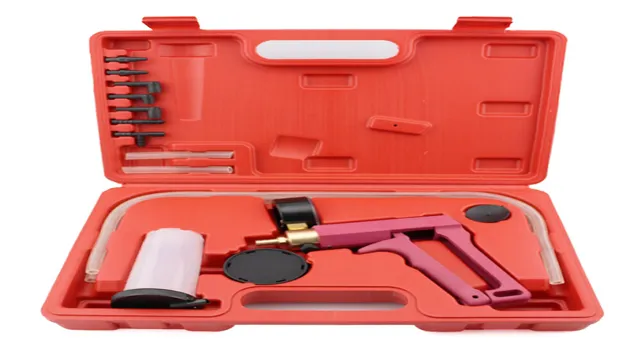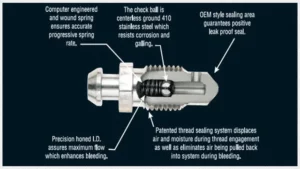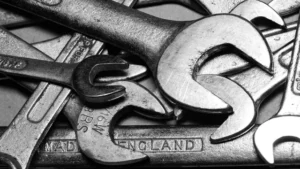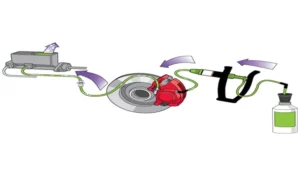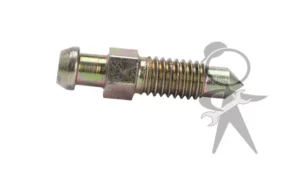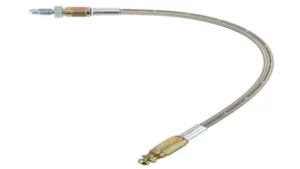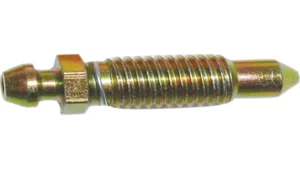Have you ever tried to bleed brakes by yourself and found that it is almost impossible to do so effectively? Fear not, a hand held brake bleeder vacuum pump is the solution you have been looking for! This handy tool will make brake bleeding quick and effortless, giving you the confidence to tackle the task on your own and avoid costly service fees. The vacuum pump works by drawing air out of the brake line, creating a vacuum that pulls out old brake fluid and air bubbles. This process ensures a complete and thorough brake bleed, protecting you and your vehicle in the long term.
Not only does using a brake bleeder vacuum pump save you money, but it also saves you time. No longer will you have to struggle with a second person to pump the brakes while you go under the vehicle and open the bleeder screw. You can now complete the task with ease all by yourself.
Investing in a hand held brake bleeder vacuum pump is a wise choice for any vehicle owner. It is a tool that pays for itself over time and ensures your brakes are working at their best. So, why wait? Get a brake bleeder vacuum pump today and give yourself the confidence to tackle any brake bleeding job.
What is a Hand Held Brake Bleeder Vacuum Pump?
If you’re one of those people who likes to do their own car maintenance, a hand held brake bleeder vacuum pump is a tool you definitely need to get. This little device helps you bleed the brakes on your car quickly and easily, without the need for an extra pair of hands. So, how do you use it? First, you need to fill the brake fluid reservoir to the proper level, then locate the bleeder valve on each brake caliper.
Next, you attach the vacuum pump to the bleeder valve, open the valve, and use the pump to create a vacuum. This causes the old fluid and air bubbles to be pulled out of the brake line, and new fluid to be pulled in. Once the fluid coming out of the bleeder valve runs clear, you close the valve and move on to the next one until you’ve bled all four brakes.
It may take a little time and effort, but using a hand held brake bleeder vacuum pump is a great way to keep your brakes in top working order.
Description and Functionality
A hand held brake bleeder vacuum pump is a tool used to bleed brakes on a vehicle. It works by attaching a hose to the brake bleeder valve, creating a vacuum to remove any air or contaminants from the brake lines. The hand held aspect of the tool makes it easy to use with one hand while the other hand opens and closes the valve.
This tool is essential for any DIY mechanic as it ensures the brakes are functioning properly. It’s like having your very own brake flushing tool in the palm of your hand, making brake maintenance a breeze. With its compact size, you can easily take it with you on the go, making it a handy tool to have in your garage or trunk.
Don’t let your brakes go unchecked, invest in a hand held brake bleeder vacuum pump and have peace of mind when driving.
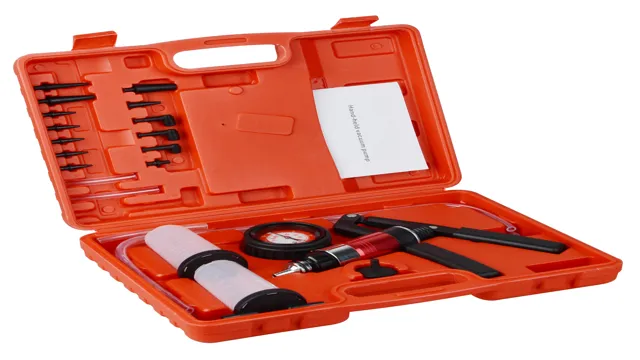
Step-by-Step Guide
If you’re looking to bleed brakes on your vehicle, using a hand-held brake bleeder vacuum pump can make the job a lot easier. Here’s a step-by-step guide on how to use one: First, attach the pump to the brake caliper’s bleeder valve using the correct size adapter. Then, fill the pump’s reservoir with brake fluid and pump it until you see fluid start to come out of the bleeder valve and into the collection jar.
As you pump, keep an eye on the fluid level in the reservoir and top it up as needed. Once the brake fluid runs clear and there are no bubbles, close the bleeder valve and remove the pump. Finally, check the brake fluid level in the master cylinder and top it up as needed before testing the brakes.
With a little patience and a good hand-held brake bleeder vacuum pump, you can take care of your vehicle’s brakes quickly and easily.
Step 1: Prepping Your Vehicle
When it comes to prepping your vehicle for a trip, there are a few key steps to keep in mind. First and foremost, it’s important to make sure that your vehicle is in good working condition. This means checking the oil, transmission fluid, brakes, tires, and other essential components to ensure that everything is up-to-date and functioning properly.
It’s also a good idea to top off your fuel tank and make sure that any necessary repairs or maintenance tasks have been taken care of before hitting the road. By taking these steps, you can ensure that your vehicle is ready to go and that you’ll be able to enjoy a safe and comfortable journey no matter where you’re headed. So why wait? Start prepping your car today and get ready for a trip you won’t forget!
Step 2: Attaching the Hand Held Bleeder Vacuum Pump
Attaching the hand held bleeder vacuum pump is an essential step in the process of bleeding your vehicle’s brakes effectively. To get started, locate the bleeder valve on your vehicle’s brake caliper. Then, take the hand held bleeder vacuum pump and attach the hose to the bleeder valve.
Once attached, use the pump to create a vacuum in the brake system. This vacuum will help pull the old brake fluid and any air bubbles out of the system. Be sure to monitor the brake fluid level during this process to avoid the pump running dry and potentially introducing more air bubbles into the system.
As you pump, you should see the brake fluid come out of the bleeder valve, and you will know that the process is working correctly. Ultimately, by attaching the hand held bleeder vacuum pump properly, you can ensure that your vehicle has a well-functioning brake system, making it safer to drive.
Step 3: Pumping the Brake Pedal
When it comes to pumping the brake pedal, there are a few things you need to keep in mind in order to do it correctly. First, it’s important to ensure that your foot is firmly on the pedal, and that you’re pushing down evenly. Next, it’s important to pump the pedal quickly and forcefully, as this will help to build up pressure in the brake lines.
It’s also important to pay close attention to how the pedal feels, as this can give you important insights into the state of your brakes. If the pedal feels spongy or soft, for example, this could be a sign that there’s air in the brake lines. On the other hand, if the pedal feels hard and unresponsive, this could be an indication that there’s too much pressure in the system.
By paying close attention to the feel of the pedal and pumping it quickly and forcefully, you’ll be able to effectively build up pressure and ensure that your brakes are in top condition.
Step 4: Emptying Brake Fluid
When it comes to brake maintenance, emptying brake fluid is a crucial step that needs to be taken seriously. Start by locating the brake fluid reservoir under the hood of your car. Using a clean cloth, wipe away any debris or dust that may have accumulated around the cap.
Twist the cap off and set it aside to allow any pressure to release. Using a turkey baster or a brake bleeding kit, remove as much of the old brake fluid from the reservoir as possible. Be sure to dispose of the old fluid properly.
Once the reservoir is empty, it’s time to refill it with fresh brake fluid. Check your car’s manual to ensure you use the correct type of brake fluid for your vehicle. Pour in the new fluid, filling it up to the “maximum” line.
Recap the reservoir and pump the brake pedal a few times to ensure the new fluid has circulated through the system. With this simple maintenance task, you can ensure your brakes are functioning properly and keep you safe on the road.
Step 5: Refilling Brake Fluid
Refilling Brake Fluid Refilling brake fluid is a crucial aspect of maintaining braking performance and overall vehicle safety. Here’s a step-by-step guide on how to refill brake fluid. Begin by selecting the appropriate brake fluid specified in your vehicle’s owner’s manual.
Locate the brake fluid reservoir and remove the cap. Wipe the reservoir clean with a lint-free cloth to prevent contamination. Use a funnel to pour the brake fluid into the reservoir to the recommended level.
Ensure that you do not overfill the reservoir. Replace the cap, and tighten it securely. Remember to always check the brake fluid level regularly to ensure it remains at a safe level.
Failure to refill brake fluid can result in poor braking performance, brake failure, or complete loss of vehicle control, which can be dangerous on the road. By following these simple steps, you can maintain a safe and responsive braking system for your vehicle.
Safety Precautions
When it comes to using a hand held brake bleeder vacuum pump, it’s important to keep safety precautions in mind. First and foremost, be sure to wear safety glasses and gloves to protect yourself from any potential debris or fluid splatters. It’s also important to work in a well-ventilated area to avoid inhaling any fumes.
Make sure the brake fluid reservoir is filled to the appropriate level and don’t exceed the pressure limit of the pump. Before beginning the bleeding process, check all connections and ensure they are tight and secure. Keep the bleeder pump away from any heat sources or open flames to prevent any fires.
Following these simple safety precautions can help ensure a successful and safe brake bleeding process using a hand held brake bleeder vacuum pump.
Protecting Yourself and Your Vehicle
When it comes to protecting yourself and your vehicle, there are a few safety precautions that you should always keep in mind. First and foremost, always wear your seatbelt when driving or riding in a car. Seatbelts have been proven to save lives and reduce the risk of injury in car accidents.
It’s also important to keep your vehicle well-maintained, including regular oil changes, tire rotations, and brake checks. This not only ensures that your car is in good working condition, but it also reduces the risk of accidents caused by mechanical failures. Additionally, always be aware of your surroundings when driving and never drive under the influence of drugs or alcohol.
By taking these safety precautions, you can protect yourself and your vehicle from harm on the road. Remember, safety should always be a top priority when it comes to driving.
Conclusion
In conclusion, using a hand held brake bleeder vacuum pump is like having a secret weapon in your garage arsenal. With the power to effortlessly and efficiently bleed your brakes, you’ll feel like a true automotive superhero. So don’t let air bubbles wreak havoc on your braking system – grab your trusty pump, save the day, and never look back.
As they say, a little pump goes a long way!”
FAQs
What is a hand held brake bleeder vacuum pump and how does it work?
A hand held brake bleeder vacuum pump is a tool used for removing air bubbles from the brake system. It works by creating a vacuum in the brake lines, which pulls fluid through the system and removes air bubbles.
How do I attach the hand held brake bleeder vacuum pump to my vehicle?
To attach the hand held brake bleeder vacuum pump to your vehicle, you will need to locate the brake bleeder valve on each wheel and connect the pump to it using the provided hoses and adapters.
Do I need to bleed all four wheels of my vehicle?
Yes, it is recommended to bleed all four wheels of your vehicle to ensure the entire brake system is free of air bubbles.
How do I know when all air bubbles have been removed from the brake system?
You will know all air bubbles have been removed from the brake system when the brake pedal feels firm and consistent when pressed.
Can I use a hand held brake bleeder vacuum pump on a vehicle with ABS brakes?
Yes, a hand held brake bleeder vacuum pump can be used on a vehicle with ABS brakes. However, it is important to follow the manufacturer’s instructions and bleed the brakes in the correct sequence.
How often should I bleed my brakes using a hand held brake bleeder vacuum pump?
It is recommended to bleed your brakes using a hand held brake bleeder vacuum pump at least once a year or as needed if you notice sponginess or inconsistency in your brake pedal.
Can a beginner use a hand held brake bleeder vacuum pump?
Yes, a hand held brake bleeder vacuum pump is easy to use with proper instructions and can be used by beginners with minimal experience. However, it is important to follow the safety instructions and wear protective gear.
